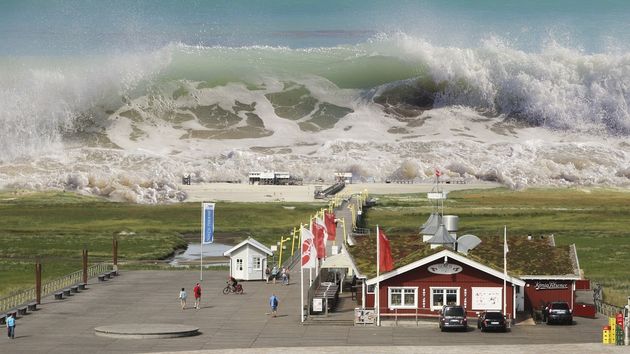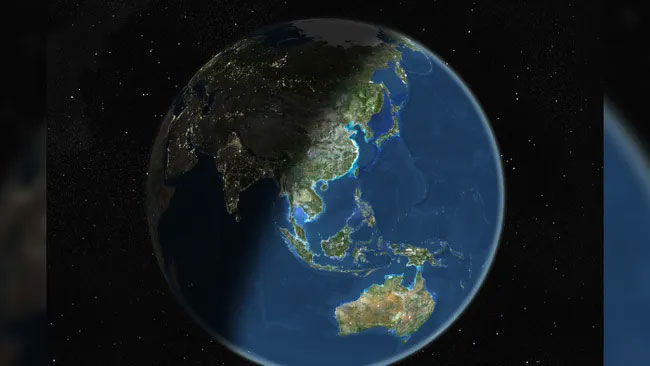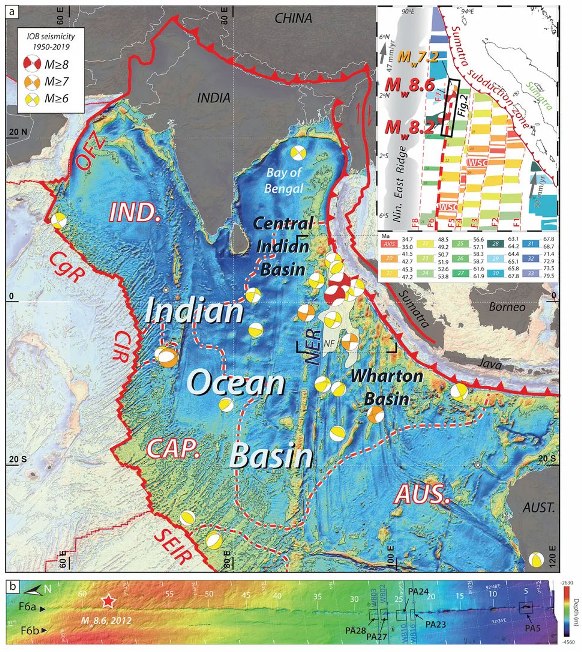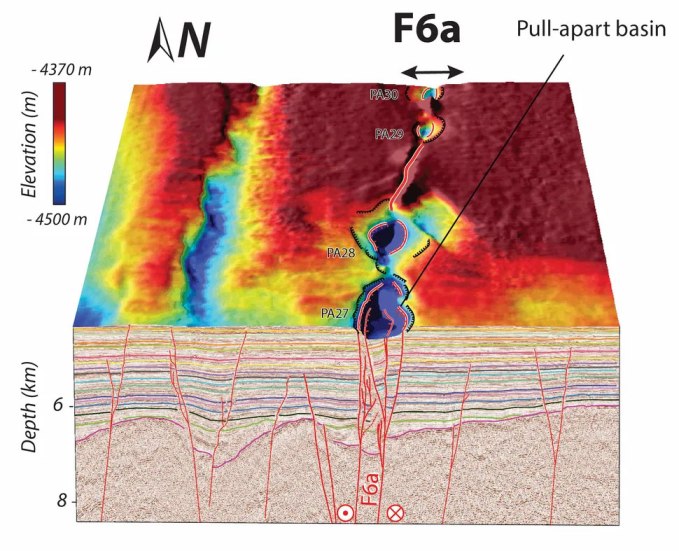The Earth is starting to shake because of global warming. Tectonic plates are moving apart regardless of warming: the giant tectonic plate under the Indian Ocean is splitting apart, the Dead Sea Fault in the Middle East is moving about twice as fast, or 0.2 inches (0.4 cm) per year, while the San Andreas Fault in California is moving about 10 times faster, about 0.7 inches (1.8 cm) per year.
The Earth is starting to shake due to global warming. Scientists have discovered the many faces of global warming: in particular, it not only accelerates the melting of glaciers, raising the level of the World Ocean, but also leads to seismic activity. Moreover, the “shakes” are recorded not only on land, but also on the ocean floor.
We are not talking about traditional earthquakes, but about seismic microwaves. They occur when the ocean sways violently, causing its waves to rise and then crash down with force, impacting the shores and the seabed, its bottom rocks. These impacts are recorded by sensitive seismic instruments as a stable noise, which scientists call global microseisms. As studies show, the global energy of ocean waves in the last twenty years of the last century increased by an average of 0.27% each year. In the current century, the average annual growth has increased to 0.35%, reports the journal Nature Communications.

Such seismic activity itself does not pose any threat, but it is a marker of events that can become catastrophic. The highest total microseismic energy was recorded in the Southern Ocean near Antarctica, and recently it has begun to increase sharply in the North Atlantic. All these are alarming signals. They mean that the World Ocean in the 21st century is “worried” more than before. Moreover, such an increase in the energy of ocean waves coincides with the intensification of storms on the planet.
The reason for all these phenomena, according to scientists, is global warming. Why? The explanation is as follows. For decades, the ocean has been “taking on” the attacks of global warming, absorbing a huge amount of excess heat and stabilizing the temperature on Earth. This stored energy requires an outlet. Which is what the ocean does, generating more and more powerful “energy-intensive” waves: they shake the Earth more and more strongly, increasing the destructive impact on the coastline and bottom rocks.
A giant tectonic plate beneath the Indian Ocean is splitting apart. According to a new study, the plate will soon (in geological terms) break into two pieces, the journal Geophysical Research Letters reports.
For humans, however, this breakup will take forever. The plate, known as the India-Australia-Capricorn tectonic plate, is splitting at a rate of about 0.06 inches (1.7 millimeters) per year. In other words, in 1 million years, the two halves of the plate will be about 1 mile (1.7 kilometers) further apart than they are now.
“This structure is not moving fast, but it is still significant compared to other boundaries on the planet,” said study co-author Aurelie Coudourie-Courveur, a senior researcher in marine geosciences at the Institut de Physique du Globe in Paris.

The tectonic plate between India and Australia beneath the Indian Ocean is very slowly breaking apart. Planet Observer/Universal Images
For example, the Dead Sea fault in the Middle East is moving about twice as fast, or 0.2 inches (0.4 cm) per year, while the San Andreas fault in California is moving about 10 times faster, at about 0.7 inches (1.8 cm) per year.
The plate is splitting so slowly and is so deep underwater that researchers almost missed what they call an “incipient plate boundary.” But two important clues—namely, two powerful earthquakes in an odd location in the Indian Ocean—suggest that Earth-shaping forces are already at work.
On April 11, 2012, an earthquake measuring between 8.6 and 8.2 magnitudes occurred under the Indian Ocean, near Indonesia. The quakes did not occur along a subduction zone, where one tectonic plate slides under another. Instead, these quakes occurred in an odd place for earthquakes to occur: in the middle of a plate.
These earthquakes, as well as other geological clues, indicated that some kind of deformation was occurring deep underground, in an area known as the Wharton Basin. This deformation was not entirely unexpected; the India-Australia-Capricorn plate is not a single unit.
It’s like a puzzle. It’s not one uniform plate. There are three plates that are more or less connected to each other and move in the same direction together.
The team studied a specific fault zone in the Wharton Basin where the earthquakes originated. Two data sets for the area, collected by other scientists on research vessels in 2015 and 2016, revealed the fault zone’s topography. By recording how long it took for sound waves to bounce off the seafloor and sediment-covered bedrock, the vessel’s scientists were able to map the basin’s geography. (Study co-author Satish Singh, a visiting professor of seismology at the Earth Observatory of Singapore, led the expedition for the 2015 data set.)

Map showing the Wharton Basin, where the 2012 magnitude 8.6 and 8.2 earthquakes occurred (red and white dots). The area has also experienced other earthquakes in the past few decades, likely due to the formation of a new tectonic plate boundary there. Coudurier‐Curveur, A. et al. Geophysical Research
When Coudourieu-Courveur and her colleagues examined the two data sets, they found evidence of ruptures, which are depressions formed by strike-slip faults. The most famous strike-slip fault is probably the San Andreas Fault. These types of faults cause earthquakes when two blocks of Earth slide past each other horizontally.
Remarkably, the team found 62 such avulsion basins along a mapped fault zone that stretched nearly 217 miles (350 km) long, though it’s likely longer, Coudourieu-Courveur said. Some of these basins were enormous — up to 1.8 miles (3 km) wide and 5 miles (8 km) long.
Moreover, the depressions were deeper in the south – up to 394 feet (120 meters) – and shallower in the north – up to 16 feet (5 meters).
“This may mean that this strike-slip fault is more localized on its southern margin, at least for now,” Coudourieu-Courveur said. The term “localized” means that the shaking is occurring on one main fault, rather than “distributed,” where shaking occurs on several smaller faults, she said.

This map shows the topography of the seafloor and the deformation beneath it at a fault in the Wharton Basin. This fault likely formed when the oceanic crust was forming, but is now being transformed into a new plate boundary. The purple indentations indicate a strike-slip fault, which is the same type of fault as the San Andreas Fault in California. Aurélie Coudourieu-Courvère
These basins, which began forming about 2.3 million years ago, followed a line that ran near the epicenters of the 2012 earthquakes.
“It looks like it’s not a fully formed plate boundary yet,” William Hawley, a seismologist at the Lamont-Doherty Earth Observatory at Columbia University in New York who was not involved in the study, told Live Science. “But the takeaway is that it’s becoming one, and that probably accounts for a lot of the deformation that we know is happening there.”
Coudourieu-Courveur noted that the fault zone, a weakness in the oceanic crust, was not created by earthquakes. Rather, these so-called passive cracks formed, in part, when new oceanic crust emerged from the mid-ocean ridge (the boundary between plates where magma emerges) and cracked due to the curvature of the Earth.
Now, that fault zone is being repurposed. “Nature likes to exploit weaknesses, it likes to exploit what’s already there,” Coudourieux-Courveur said.
Because different parts of the Indo-Australia-Capricorn Plate are moving at different speeds, this fault zone, once just a passive crack, is becoming a new boundary for the plate to split into two parts, she said.
However, because the rift between India, Australia and Capricorn is happening so slowly, another major earthquake along that particular fault is unlikely to occur for at least another 20,000 years, the researchers say. In fact, it will take tens of millions of years before the rift is complete, Coudourieu-Courveur said.




